NRSG370 Clinical Integration: Personal Reflection on Teen Suicide
VerifiedAdded on 2023/04/05
|7
|1234
|93
Report
AI Summary
This report presents a personal reflection on teen suicide prevention, prompted by the tragic death of a 17-year-old boy. The reflection incorporates reporting on suicide statistics, responding to the mother's experience, relating the incident to existing knowledge of risk factors such as academic stress and family dynamics, reasoning about potential causes based on stress-diathesis models and undiagnosed mental health issues like Asperger's, and reconstructing future practice by emphasizing empathetic communication, health promotion among parents and teachers, and awareness of coping strategies. The report also includes an action plan for teenage suicide prevention, focusing on educating parents and teachers on empathetic communication, problem-solving strategies, risk factors, and the importance of observing student behavior and academic performance. The student reflects on the need for further research and experience to handle complex cases effectively, emphasizing the importance of a multi-faceted approach involving parents, teachers, and mental health professionals.
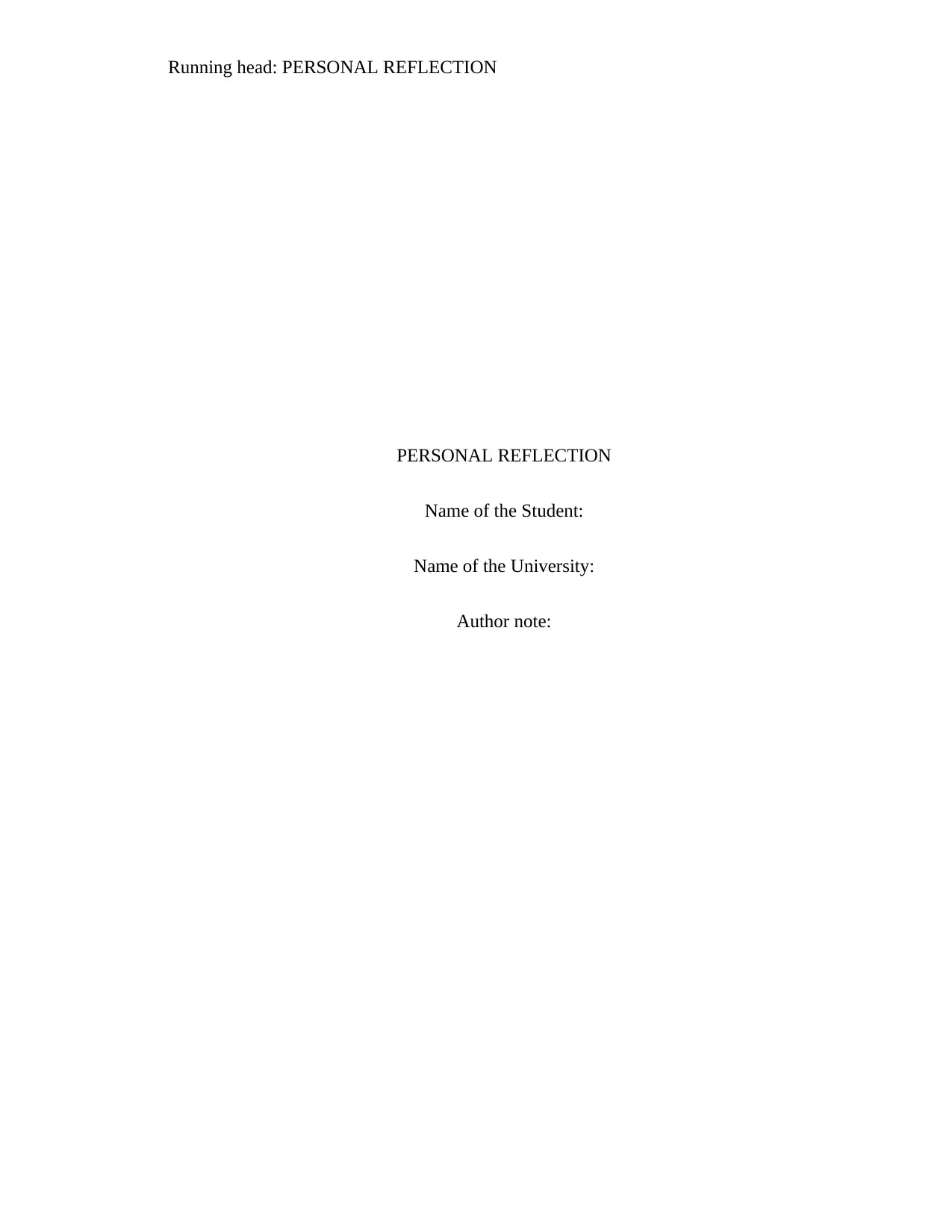
Running head: PERSONAL REFLECTION
PERSONAL REFLECTION
Name of the Student:
Name of the University:
Author note:
PERSONAL REFLECTION
Name of the Student:
Name of the University:
Author note:
Paraphrase This Document
Need a fresh take? Get an instant paraphrase of this document with our AI Paraphraser
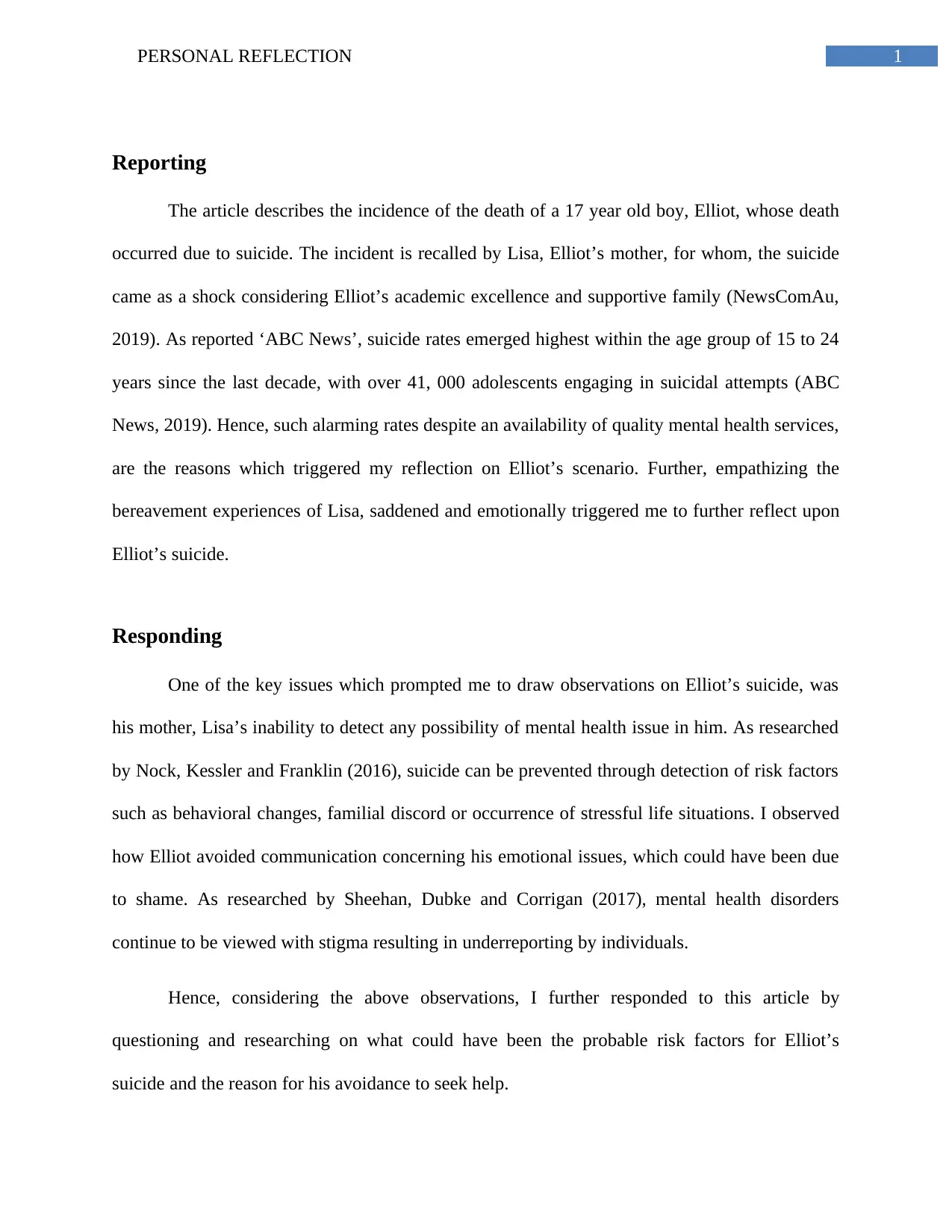
1PERSONAL REFLECTION
Reporting
The article describes the incidence of the death of a 17 year old boy, Elliot, whose death
occurred due to suicide. The incident is recalled by Lisa, Elliot’s mother, for whom, the suicide
came as a shock considering Elliot’s academic excellence and supportive family (NewsComAu,
2019). As reported ‘ABC News’, suicide rates emerged highest within the age group of 15 to 24
years since the last decade, with over 41, 000 adolescents engaging in suicidal attempts (ABC
News, 2019). Hence, such alarming rates despite an availability of quality mental health services,
are the reasons which triggered my reflection on Elliot’s scenario. Further, empathizing the
bereavement experiences of Lisa, saddened and emotionally triggered me to further reflect upon
Elliot’s suicide.
Responding
One of the key issues which prompted me to draw observations on Elliot’s suicide, was
his mother, Lisa’s inability to detect any possibility of mental health issue in him. As researched
by Nock, Kessler and Franklin (2016), suicide can be prevented through detection of risk factors
such as behavioral changes, familial discord or occurrence of stressful life situations. I observed
how Elliot avoided communication concerning his emotional issues, which could have been due
to shame. As researched by Sheehan, Dubke and Corrigan (2017), mental health disorders
continue to be viewed with stigma resulting in underreporting by individuals.
Hence, considering the above observations, I further responded to this article by
questioning and researching on what could have been the probable risk factors for Elliot’s
suicide and the reason for his avoidance to seek help.
Reporting
The article describes the incidence of the death of a 17 year old boy, Elliot, whose death
occurred due to suicide. The incident is recalled by Lisa, Elliot’s mother, for whom, the suicide
came as a shock considering Elliot’s academic excellence and supportive family (NewsComAu,
2019). As reported ‘ABC News’, suicide rates emerged highest within the age group of 15 to 24
years since the last decade, with over 41, 000 adolescents engaging in suicidal attempts (ABC
News, 2019). Hence, such alarming rates despite an availability of quality mental health services,
are the reasons which triggered my reflection on Elliot’s scenario. Further, empathizing the
bereavement experiences of Lisa, saddened and emotionally triggered me to further reflect upon
Elliot’s suicide.
Responding
One of the key issues which prompted me to draw observations on Elliot’s suicide, was
his mother, Lisa’s inability to detect any possibility of mental health issue in him. As researched
by Nock, Kessler and Franklin (2016), suicide can be prevented through detection of risk factors
such as behavioral changes, familial discord or occurrence of stressful life situations. I observed
how Elliot avoided communication concerning his emotional issues, which could have been due
to shame. As researched by Sheehan, Dubke and Corrigan (2017), mental health disorders
continue to be viewed with stigma resulting in underreporting by individuals.
Hence, considering the above observations, I further responded to this article by
questioning and researching on what could have been the probable risk factors for Elliot’s
suicide and the reason for his avoidance to seek help.
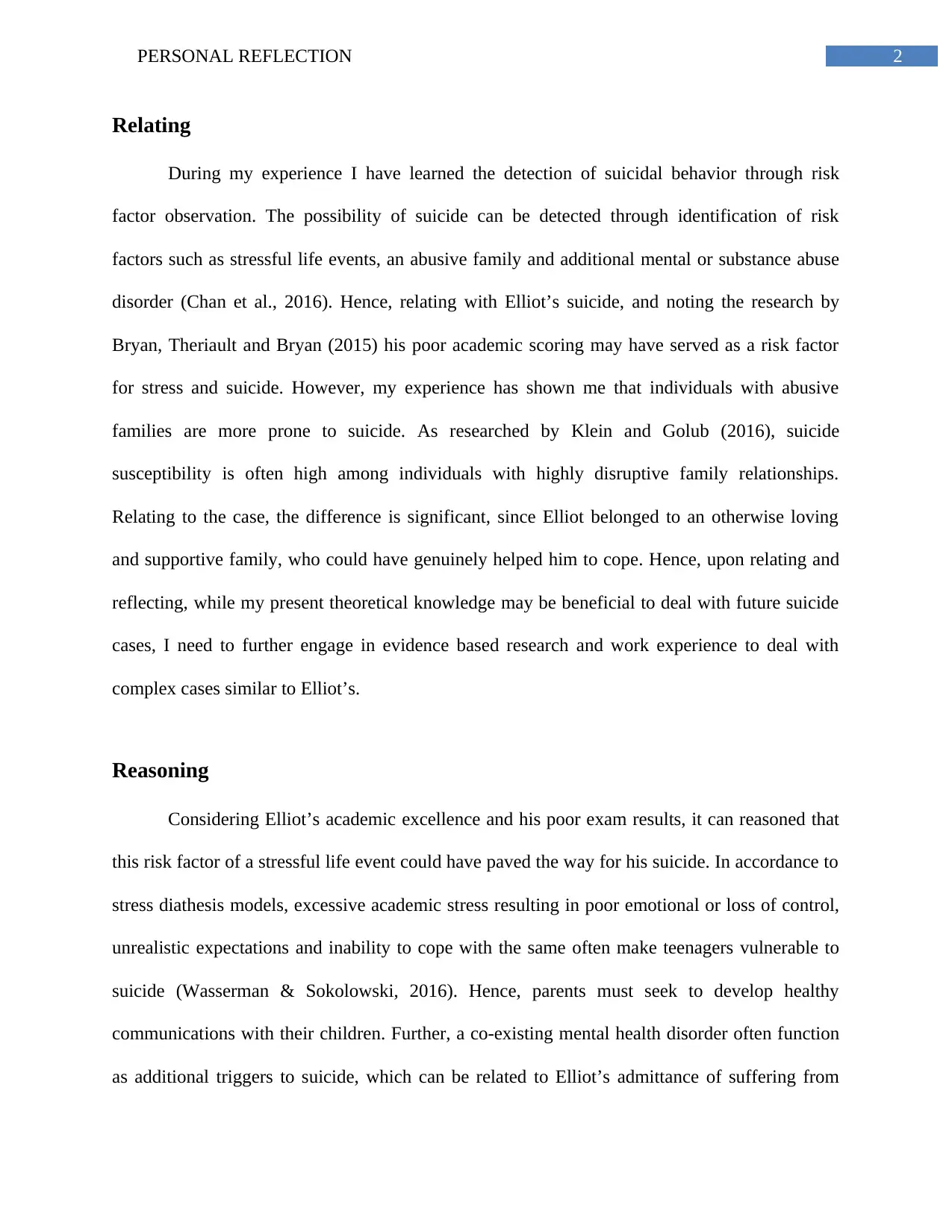
2PERSONAL REFLECTION
Relating
During my experience I have learned the detection of suicidal behavior through risk
factor observation. The possibility of suicide can be detected through identification of risk
factors such as stressful life events, an abusive family and additional mental or substance abuse
disorder (Chan et al., 2016). Hence, relating with Elliot’s suicide, and noting the research by
Bryan, Theriault and Bryan (2015) his poor academic scoring may have served as a risk factor
for stress and suicide. However, my experience has shown me that individuals with abusive
families are more prone to suicide. As researched by Klein and Golub (2016), suicide
susceptibility is often high among individuals with highly disruptive family relationships.
Relating to the case, the difference is significant, since Elliot belonged to an otherwise loving
and supportive family, who could have genuinely helped him to cope. Hence, upon relating and
reflecting, while my present theoretical knowledge may be beneficial to deal with future suicide
cases, I need to further engage in evidence based research and work experience to deal with
complex cases similar to Elliot’s.
Reasoning
Considering Elliot’s academic excellence and his poor exam results, it can reasoned that
this risk factor of a stressful life event could have paved the way for his suicide. In accordance to
stress diathesis models, excessive academic stress resulting in poor emotional or loss of control,
unrealistic expectations and inability to cope with the same often make teenagers vulnerable to
suicide (Wasserman & Sokolowski, 2016). Hence, parents must seek to develop healthy
communications with their children. Further, a co-existing mental health disorder often function
as additional triggers to suicide, which can be related to Elliot’s admittance of suffering from
Relating
During my experience I have learned the detection of suicidal behavior through risk
factor observation. The possibility of suicide can be detected through identification of risk
factors such as stressful life events, an abusive family and additional mental or substance abuse
disorder (Chan et al., 2016). Hence, relating with Elliot’s suicide, and noting the research by
Bryan, Theriault and Bryan (2015) his poor academic scoring may have served as a risk factor
for stress and suicide. However, my experience has shown me that individuals with abusive
families are more prone to suicide. As researched by Klein and Golub (2016), suicide
susceptibility is often high among individuals with highly disruptive family relationships.
Relating to the case, the difference is significant, since Elliot belonged to an otherwise loving
and supportive family, who could have genuinely helped him to cope. Hence, upon relating and
reflecting, while my present theoretical knowledge may be beneficial to deal with future suicide
cases, I need to further engage in evidence based research and work experience to deal with
complex cases similar to Elliot’s.
Reasoning
Considering Elliot’s academic excellence and his poor exam results, it can reasoned that
this risk factor of a stressful life event could have paved the way for his suicide. In accordance to
stress diathesis models, excessive academic stress resulting in poor emotional or loss of control,
unrealistic expectations and inability to cope with the same often make teenagers vulnerable to
suicide (Wasserman & Sokolowski, 2016). Hence, parents must seek to develop healthy
communications with their children. Further, a co-existing mental health disorder often function
as additional triggers to suicide, which can be related to Elliot’s admittance of suffering from
⊘ This is a preview!⊘
Do you want full access?
Subscribe today to unlock all pages.

Trusted by 1+ million students worldwide
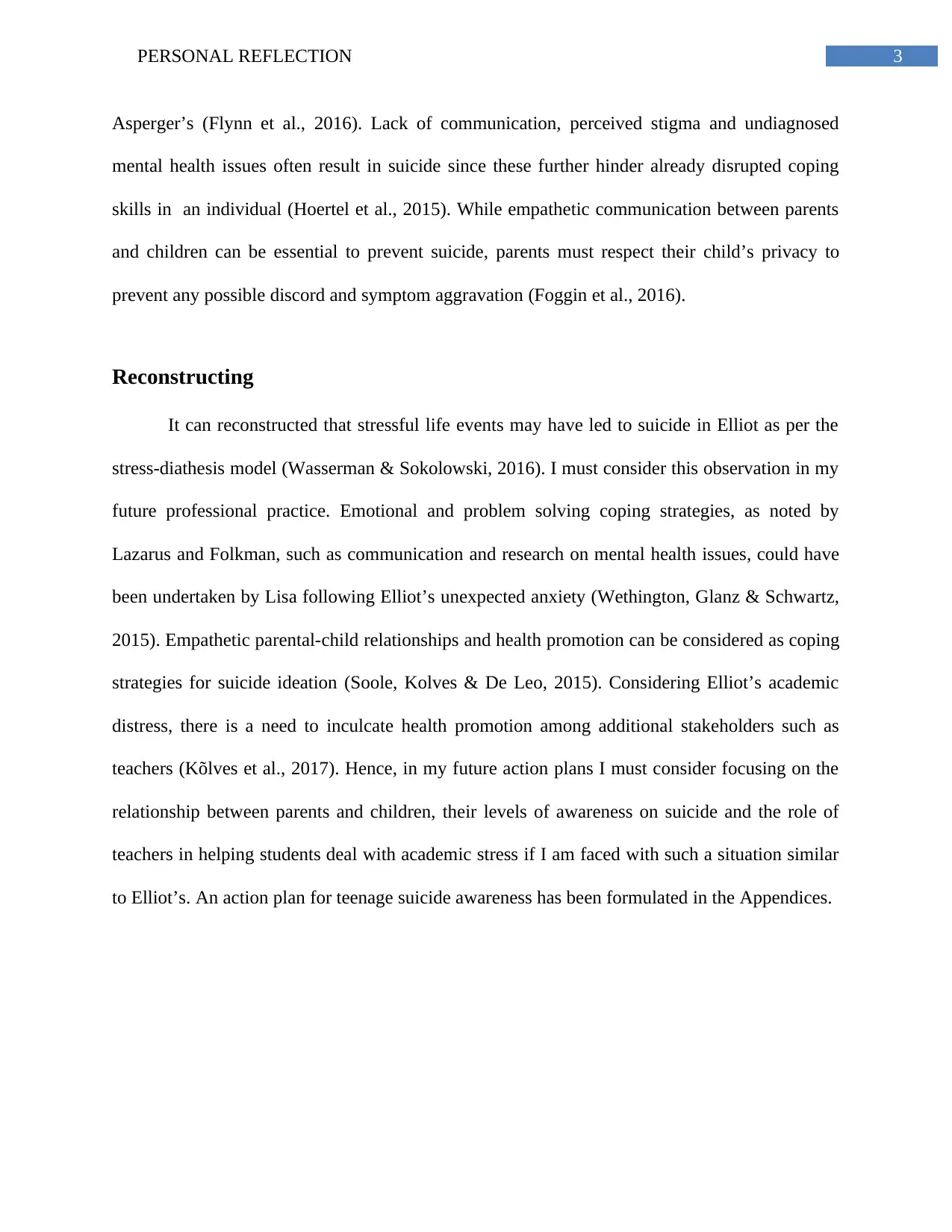
3PERSONAL REFLECTION
Asperger’s (Flynn et al., 2016). Lack of communication, perceived stigma and undiagnosed
mental health issues often result in suicide since these further hinder already disrupted coping
skills in an individual (Hoertel et al., 2015). While empathetic communication between parents
and children can be essential to prevent suicide, parents must respect their child’s privacy to
prevent any possible discord and symptom aggravation (Foggin et al., 2016).
Reconstructing
It can reconstructed that stressful life events may have led to suicide in Elliot as per the
stress-diathesis model (Wasserman & Sokolowski, 2016). I must consider this observation in my
future professional practice. Emotional and problem solving coping strategies, as noted by
Lazarus and Folkman, such as communication and research on mental health issues, could have
been undertaken by Lisa following Elliot’s unexpected anxiety (Wethington, Glanz & Schwartz,
2015). Empathetic parental-child relationships and health promotion can be considered as coping
strategies for suicide ideation (Soole, Kolves & De Leo, 2015). Considering Elliot’s academic
distress, there is a need to inculcate health promotion among additional stakeholders such as
teachers (Kõlves et al., 2017). Hence, in my future action plans I must consider focusing on the
relationship between parents and children, their levels of awareness on suicide and the role of
teachers in helping students deal with academic stress if I am faced with such a situation similar
to Elliot’s. An action plan for teenage suicide awareness has been formulated in the Appendices.
Asperger’s (Flynn et al., 2016). Lack of communication, perceived stigma and undiagnosed
mental health issues often result in suicide since these further hinder already disrupted coping
skills in an individual (Hoertel et al., 2015). While empathetic communication between parents
and children can be essential to prevent suicide, parents must respect their child’s privacy to
prevent any possible discord and symptom aggravation (Foggin et al., 2016).
Reconstructing
It can reconstructed that stressful life events may have led to suicide in Elliot as per the
stress-diathesis model (Wasserman & Sokolowski, 2016). I must consider this observation in my
future professional practice. Emotional and problem solving coping strategies, as noted by
Lazarus and Folkman, such as communication and research on mental health issues, could have
been undertaken by Lisa following Elliot’s unexpected anxiety (Wethington, Glanz & Schwartz,
2015). Empathetic parental-child relationships and health promotion can be considered as coping
strategies for suicide ideation (Soole, Kolves & De Leo, 2015). Considering Elliot’s academic
distress, there is a need to inculcate health promotion among additional stakeholders such as
teachers (Kõlves et al., 2017). Hence, in my future action plans I must consider focusing on the
relationship between parents and children, their levels of awareness on suicide and the role of
teachers in helping students deal with academic stress if I am faced with such a situation similar
to Elliot’s. An action plan for teenage suicide awareness has been formulated in the Appendices.
Paraphrase This Document
Need a fresh take? Get an instant paraphrase of this document with our AI Paraphraser
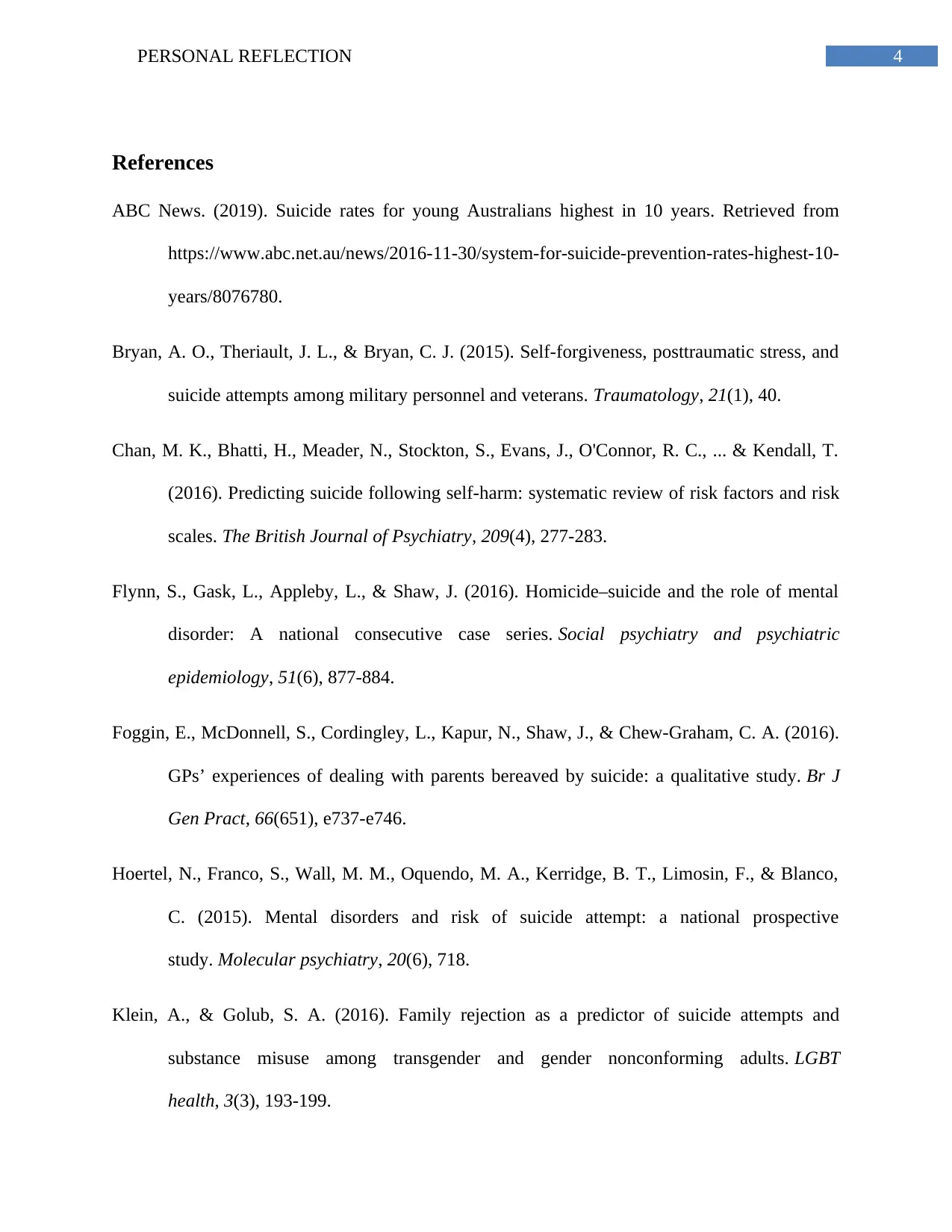
4PERSONAL REFLECTION
References
ABC News. (2019). Suicide rates for young Australians highest in 10 years. Retrieved from
https://www.abc.net.au/news/2016-11-30/system-for-suicide-prevention-rates-highest-10-
years/8076780.
Bryan, A. O., Theriault, J. L., & Bryan, C. J. (2015). Self-forgiveness, posttraumatic stress, and
suicide attempts among military personnel and veterans. Traumatology, 21(1), 40.
Chan, M. K., Bhatti, H., Meader, N., Stockton, S., Evans, J., O'Connor, R. C., ... & Kendall, T.
(2016). Predicting suicide following self-harm: systematic review of risk factors and risk
scales. The British Journal of Psychiatry, 209(4), 277-283.
Flynn, S., Gask, L., Appleby, L., & Shaw, J. (2016). Homicide–suicide and the role of mental
disorder: A national consecutive case series. Social psychiatry and psychiatric
epidemiology, 51(6), 877-884.
Foggin, E., McDonnell, S., Cordingley, L., Kapur, N., Shaw, J., & Chew-Graham, C. A. (2016).
GPs’ experiences of dealing with parents bereaved by suicide: a qualitative study. Br J
Gen Pract, 66(651), e737-e746.
Hoertel, N., Franco, S., Wall, M. M., Oquendo, M. A., Kerridge, B. T., Limosin, F., & Blanco,
C. (2015). Mental disorders and risk of suicide attempt: a national prospective
study. Molecular psychiatry, 20(6), 718.
Klein, A., & Golub, S. A. (2016). Family rejection as a predictor of suicide attempts and
substance misuse among transgender and gender nonconforming adults. LGBT
health, 3(3), 193-199.
References
ABC News. (2019). Suicide rates for young Australians highest in 10 years. Retrieved from
https://www.abc.net.au/news/2016-11-30/system-for-suicide-prevention-rates-highest-10-
years/8076780.
Bryan, A. O., Theriault, J. L., & Bryan, C. J. (2015). Self-forgiveness, posttraumatic stress, and
suicide attempts among military personnel and veterans. Traumatology, 21(1), 40.
Chan, M. K., Bhatti, H., Meader, N., Stockton, S., Evans, J., O'Connor, R. C., ... & Kendall, T.
(2016). Predicting suicide following self-harm: systematic review of risk factors and risk
scales. The British Journal of Psychiatry, 209(4), 277-283.
Flynn, S., Gask, L., Appleby, L., & Shaw, J. (2016). Homicide–suicide and the role of mental
disorder: A national consecutive case series. Social psychiatry and psychiatric
epidemiology, 51(6), 877-884.
Foggin, E., McDonnell, S., Cordingley, L., Kapur, N., Shaw, J., & Chew-Graham, C. A. (2016).
GPs’ experiences of dealing with parents bereaved by suicide: a qualitative study. Br J
Gen Pract, 66(651), e737-e746.
Hoertel, N., Franco, S., Wall, M. M., Oquendo, M. A., Kerridge, B. T., Limosin, F., & Blanco,
C. (2015). Mental disorders and risk of suicide attempt: a national prospective
study. Molecular psychiatry, 20(6), 718.
Klein, A., & Golub, S. A. (2016). Family rejection as a predictor of suicide attempts and
substance misuse among transgender and gender nonconforming adults. LGBT
health, 3(3), 193-199.
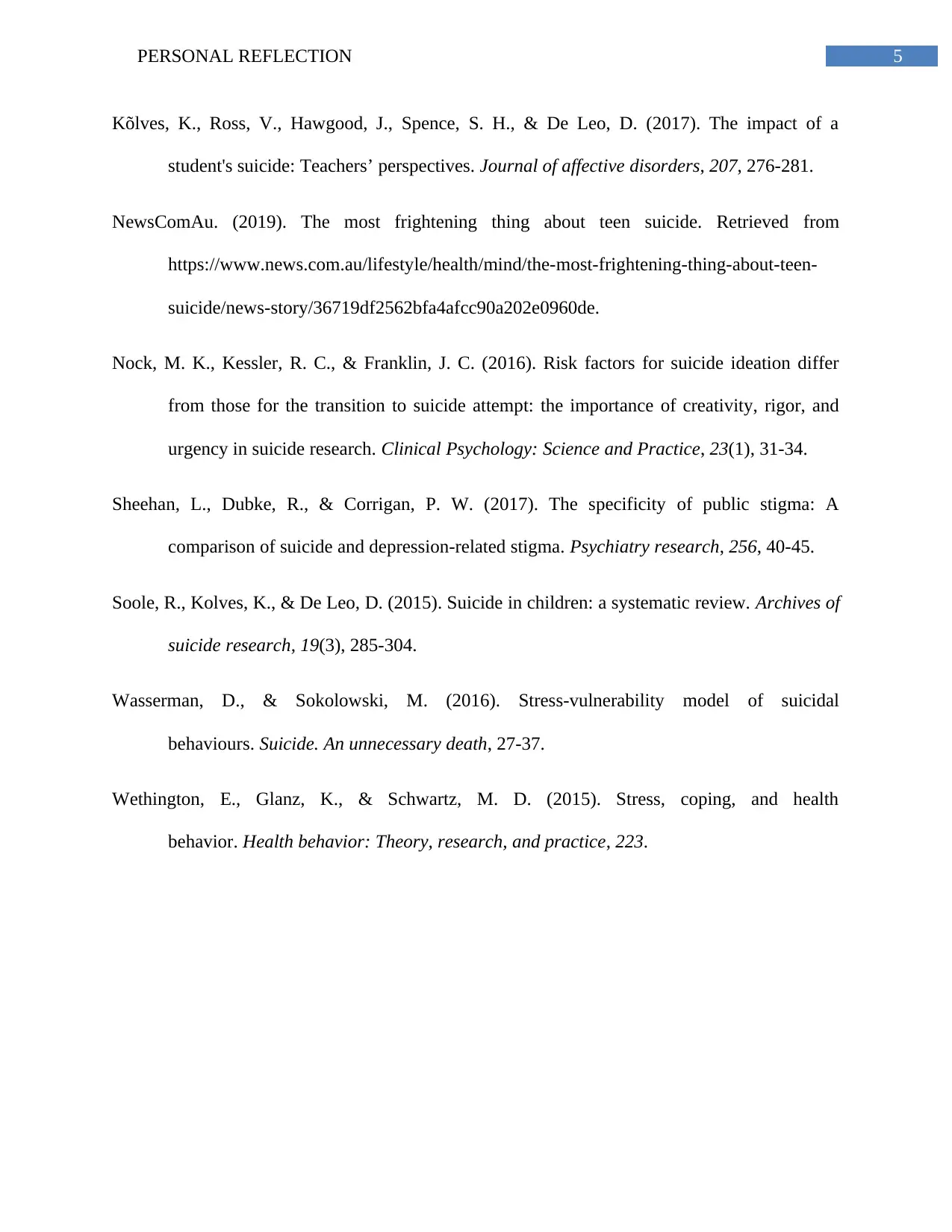
5PERSONAL REFLECTION
Kõlves, K., Ross, V., Hawgood, J., Spence, S. H., & De Leo, D. (2017). The impact of a
student's suicide: Teachers’ perspectives. Journal of affective disorders, 207, 276-281.
NewsComAu. (2019). The most frightening thing about teen suicide. Retrieved from
https://www.news.com.au/lifestyle/health/mind/the-most-frightening-thing-about-teen-
suicide/news-story/36719df2562bfa4afcc90a202e0960de.
Nock, M. K., Kessler, R. C., & Franklin, J. C. (2016). Risk factors for suicide ideation differ
from those for the transition to suicide attempt: the importance of creativity, rigor, and
urgency in suicide research. Clinical Psychology: Science and Practice, 23(1), 31-34.
Sheehan, L., Dubke, R., & Corrigan, P. W. (2017). The specificity of public stigma: A
comparison of suicide and depression-related stigma. Psychiatry research, 256, 40-45.
Soole, R., Kolves, K., & De Leo, D. (2015). Suicide in children: a systematic review. Archives of
suicide research, 19(3), 285-304.
Wasserman, D., & Sokolowski, M. (2016). Stress-vulnerability model of suicidal
behaviours. Suicide. An unnecessary death, 27-37.
Wethington, E., Glanz, K., & Schwartz, M. D. (2015). Stress, coping, and health
behavior. Health behavior: Theory, research, and practice, 223.
Kõlves, K., Ross, V., Hawgood, J., Spence, S. H., & De Leo, D. (2017). The impact of a
student's suicide: Teachers’ perspectives. Journal of affective disorders, 207, 276-281.
NewsComAu. (2019). The most frightening thing about teen suicide. Retrieved from
https://www.news.com.au/lifestyle/health/mind/the-most-frightening-thing-about-teen-
suicide/news-story/36719df2562bfa4afcc90a202e0960de.
Nock, M. K., Kessler, R. C., & Franklin, J. C. (2016). Risk factors for suicide ideation differ
from those for the transition to suicide attempt: the importance of creativity, rigor, and
urgency in suicide research. Clinical Psychology: Science and Practice, 23(1), 31-34.
Sheehan, L., Dubke, R., & Corrigan, P. W. (2017). The specificity of public stigma: A
comparison of suicide and depression-related stigma. Psychiatry research, 256, 40-45.
Soole, R., Kolves, K., & De Leo, D. (2015). Suicide in children: a systematic review. Archives of
suicide research, 19(3), 285-304.
Wasserman, D., & Sokolowski, M. (2016). Stress-vulnerability model of suicidal
behaviours. Suicide. An unnecessary death, 27-37.
Wethington, E., Glanz, K., & Schwartz, M. D. (2015). Stress, coping, and health
behavior. Health behavior: Theory, research, and practice, 223.
⊘ This is a preview!⊘
Do you want full access?
Subscribe today to unlock all pages.

Trusted by 1+ million students worldwide
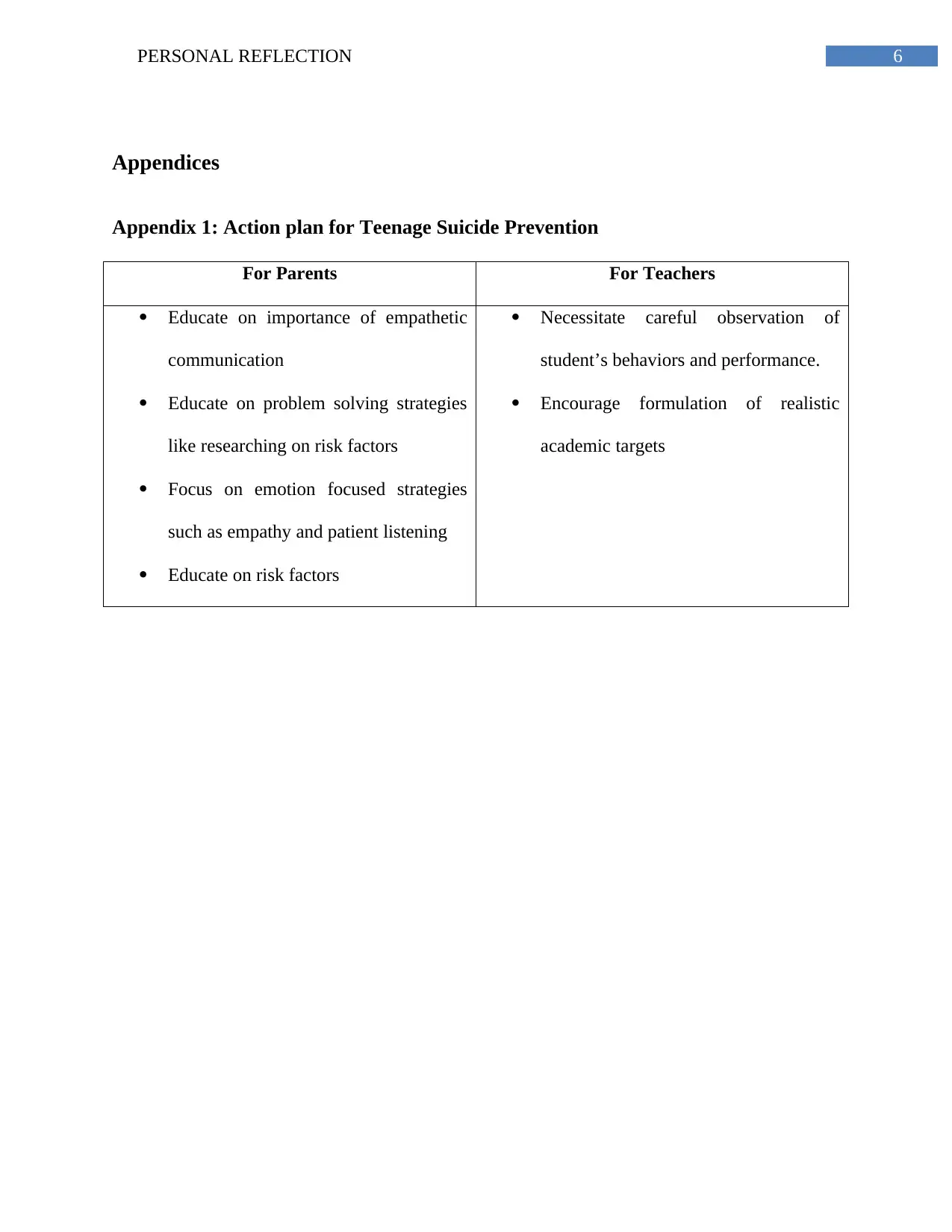
6PERSONAL REFLECTION
Appendices
Appendix 1: Action plan for Teenage Suicide Prevention
For Parents For Teachers
Educate on importance of empathetic
communication
Educate on problem solving strategies
like researching on risk factors
Focus on emotion focused strategies
such as empathy and patient listening
Educate on risk factors
Necessitate careful observation of
student’s behaviors and performance.
Encourage formulation of realistic
academic targets
Appendices
Appendix 1: Action plan for Teenage Suicide Prevention
For Parents For Teachers
Educate on importance of empathetic
communication
Educate on problem solving strategies
like researching on risk factors
Focus on emotion focused strategies
such as empathy and patient listening
Educate on risk factors
Necessitate careful observation of
student’s behaviors and performance.
Encourage formulation of realistic
academic targets
1 out of 7
Related Documents
Your All-in-One AI-Powered Toolkit for Academic Success.
+13062052269
info@desklib.com
Available 24*7 on WhatsApp / Email
![[object Object]](/_next/static/media/star-bottom.7253800d.svg)
Unlock your academic potential
Copyright © 2020–2025 A2Z Services. All Rights Reserved. Developed and managed by ZUCOL.



